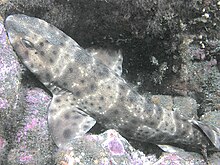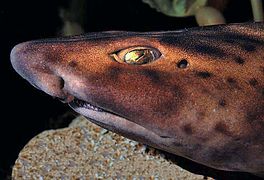Swell shark
| Swell shark | |
|---|---|

| |
| Scientific classification | |
| Domain: | Eukaryota |
| Kingdom: | Animalia |
| Phylum: | Chordata |
| Class: | Chondrichthyes |
| Subclass: | Elasmobranchii |
| Subdivision: | Selachimorpha |
| Order: | Carcharhiniformes |
| Family: | Scyliorhinidae |
| Genus: | Cephaloscyllium |
| Species: | C. ventriosum
|
| Binomial name | |
| Cephaloscyllium ventriosum (Garman, 1880)
| |
| Synonyms | |
| |
The swell shark (Cephaloscyllium ventriosum) is a
Taxonomy
When discovered in 1880, the swell shark was first described as Scyllium ventriosum, but was later changed to Cephaloscyllium ventriosum. The genus name comes from the Greek word kephale, which means "head", and skylla, which means a certain kind of shark. The species name comes from the Latin word ventrĭōsus, which means "large-bellied". The species name refers to its ability to enlarge itself by taking in water.[2]
Distribution and habitat
The swell shark is found in the eastern Pacific Ocean, from the central California coast to southern Mexico.[1][2] There is an additional population off the coast of Chile.[2][3] It can be found between the depths of 5 m and 457 m, but is most common between 5 m and 37 m.[2][1]
Swell sharks are often found over algae-covered rocky bottoms where it hides in crevices during the day.[2]
Description
Swell sharks are typically around 90 cm in length, with a maximum length of 110 cm.
Every swell shark has around 55–60 teeth.[2] Teeth typically have three smooth cusps, but can have as many as five cusps.[2] The middle cusp is the longest.[2]
-
Head
-
Jaws
-
Lower teeth
-
Upper teeth
Ecology
Swell sharks are
Reproduction

The swell shark is
Diet

Swell sharks hunt at night for
Defense
When the shark feels threatened, it will bend its body into a U–shape, grab its tail fin with its mouth, and suck in water.[2] Doing so causes the shark to enlarge in diameter and makes it much harder for predators to bite or dislodge.[2][4] The swell shark is capable of swelling by using water or air, which is stored in the stomach until released.[2][4] When letting air out, the swell shark makes a dog-like bark.[2][5] Swell sharks are non-aggressive and are considered harmless to humans.[3][2][5]

Biofluorescence

Swell shark
Conservation status

There are no fishery operations that target swell sharks, however, they are occasionally caught as bycatch in lobster and crab traps, gillnets, and trawls.
References
- ^ . Retrieved 11 November 2021.
- ^ a b c d e f g h i j k l m n o p q r s t u v w x y z aa "swell shark". Florida Museum of Natural History. Retrieved 2009-06-14.
- ^ a b c d e f g h "Cephaloscyllium ventriosum". FishBase. Retrieved 2009-07-07.
- ^ a b c d e f g h "Kelp Forest: Swell Shark". Elasmo-Research. Retrieved 2009-07-07.
- ^ a b c d e f g h "Swell Shark". www.aquariumofpacific.org. Retrieved 2018-06-22.
- ^ PMID 31402257.
- PMID 24421880.





